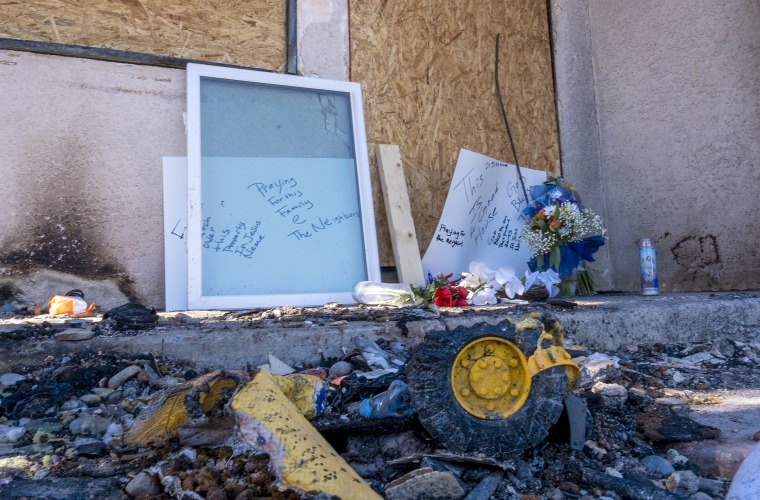[ad_1]
As community groups demand answers after a teen died of smoke inhalation during the course of a police raid, New Mexico Attorney General Hector Balderas said Wednesday that his office will independently review the department’s handling of the incident.
Brett Rosenau, 15, died earlier this month after an hourslong SWAT standoff ended with a house fire that may have been ignited by chemical munitions set off by law enforcement as they were trying to arrest another person inside, police said.
A multiagency investigation that police say will take two weeks is already underway, but Albuquerque Police Chief Harold Medina has asked Balderas to intervene “out of an abundance of caution.”
“If the chemical device is determined to be the cause of the fire, I would also request that your office provide us with an independent analysis of the device and deployment procedures,” Medina said in a letter to Balderas.
Balderas said the “tragic death of this 15-year-old is a serious matter that warrants a comprehensive review.” He also said his office has taken steps to assemble a team to examine the handling of the incident and conduct an analysis of the use of tactical devices.
Police have said on July 6 they were attempting to arrest Qiaunt Kelley, 27, for violating his probation after being convicted of armed carjacking and stolen vehicle when he retreated into a home as officers approached him. The teenage boy followed him inside and remained with him for hours as police said they attempted to coax them out peacefully.
Officers also used a drone and robots “to determine who was inside the house and to activate powder irritants inside the home to get the individuals to exit,” police said. An hour later, the house was on fire. As firefighters arrived, Kelley ran out of the home, but Rosenau was found dead inside.

Police have not said how long the fire burned before firefighters arrived. Kelley was taken to the hospital with burn injuries and then arrested on outstanding warrants.
“In our effort to track down and arrest a violent criminal, a young person tragically lost his life,” Medina said a few days after the incident. “If any of our actions inadvertently contributed to his death, we will take steps to ensure this never happens again.”
Rosenau’s death touched off a series of protests across Albuquerque, with demonstrators, including the boy’s family, demanding police accountability and calling the officers’ actions unnecessarily heavy-handed.
In particular, Rosenau’s family has raised questions about the police decision to deploy chemical irritants into the home, which Medina said may have caused the fire.
“From our vantage point that seems overkill,” said Taylor Smith, an attorney representing the boy’s family. “From what we know and reports we heard not long after the incident, police were aware that a minor child was in the home yet chose to do this.”
Rosenau was described by his family in a statement as a “smart and funny young boy who walked to the beat of his own drum.”
His family said his “teachers often believed that he would pursue engineering given his ingenuity and talents.”
Louie Sanchez, an Albuquerque City Councilor and chair of the city’s public safety committee said his committee will review the attorney general’s investigation once it’s complete.
“As a father, 26-year law enforcement veteran, and chairman of the Albuquerque Public Safety Committee, I express my deepest condolences to the family and friends of the deceased teenager,” he said in a statement.

The American Civil Liberties Union of New Mexico also urged the attorney general’s office to conduct an independent investigation into Rosenau’s death.
“There was a child inside the home and they made the decision to use the chemical weapon knowing that, so there seems to be failure on some level to retrieve him,” Leon Howard, legal director of the ACLU of New Mexico said. “There was no indication that there was some immediate threat of danger that required this type of escalation.”
Police say they used a “Tri-Chamber Flameless CS Grenade,” a device officers have used a number of times over many years without incident.
A 2015 safety data sheet required by the Occupational Safety and Health Administration, which appears on the product’s website, warns that the grenade contains “flammable solid” and that the “product may explode if burned in confined space.”
“Individual cartridges may explode. Mass explosion of many cartridges at once is unlikely,” the safety data sheet says. It adds that the product should be used “only outdoors or in a well-ventilated area.”
The website for Defense Technology, the product’s manufacturer, explains the device was “designed primarily for indoor tactical situations.”
Keith Taylor, an assistant professor at John Jay College of Criminal Justice and former SWAT officer, said law enforcement should take a number of factors into consideration before deploying chemical munitions, including who could be affected.
“The development of a tactical plan is important,” he said. “You need to assess who is going to come in contact with these weapons.”
When deploying weapons such as tear gas, chemical munitions and noise flash diversionary devices — all used by Albuquerque officers during the July 6 incident — the police plan should consider if there are elderly adults or minors present because smoke and chemicals can have an outsized effect on them, he said.
As the police response is examined, investigators will likely consider how much time police had to formulate their plan and whether they followed standard operating procedure for deploying chemical weapons indoors, Taylor said.
For instance, he said, it’s generally good practice to have firefighters on site before the deployment of chemical munitions.
The Albuquerque Police Department is under a federal consent decree agreed upon in 2014 after the U.S. government determined it had a pattern of excessive force. Under the agreement, the department is required to report details of the investigations to the Department of Justice and its independent federal monitor.
The department has said it will publicly release footage of the incident captured by police, by drone, and other videos.
[ad_2]
Source link




